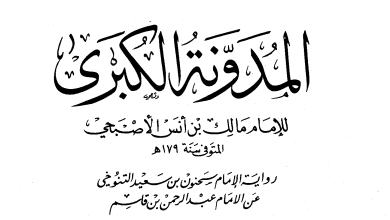A Study of Imām Muḥammad al-Shaybānī’s al-Ḥujjah ʿalā Ahl al-Madīnah
A Study of Imām Muḥammad al-Shaybānī’s al-Ḥujjah ʿalā Ahl al-Madīnah
By Dr. Nājī Lamīn
Translated by Muntasir Zaman
[Translator’s note: the following excerpt explores the legal theory of Imām Muḥammad ibn al-Ḥasan al-Shaybānī (d. 189 AH), a pioneer of the Ḥanafī school and leading acolyte of its eponym,[1] in light of his landmark polemic against the Medinese, al-Ḥujjah ʿalā Ahl al-Madīnah.[2] Given its direct link with Imām Mālik and its subsequent impression upon the writings of Imām al-Shāfiʿī, the Ḥujjah is an invaluable source for inter-madhhab scholarship. That the four legal schools are closely affiliated in both their fundamental and peripheral laws requires no introduction.[3] Shaykh Zāhid al-Kawtharī notes that these schools, who in their services towards the faith are akin to a family, converge on three-fourths of legal rulings.[4] Al-Shaybānī’s seminal role in bridging the major legal schools makes his works a fruitful starting point in understanding the development of, and academic exchange between, the most prominent legal schools.[5] Furthermore, a study of the works of jurists during the formative period of Islam is essential to appreciate the legal thought and methodology that serve as the bedrock of later Islamic jurisprudence.This excerpt forms part of a larger investigation by the author, a senior professor at Dār al-Ḥadīth al-Ḥasaniyyah in Rabat, Morocco, into early scholastic exchanges between luminaries like Imāms Mālik, al-Layth ibn Saʿd, al-Shaybānī, and al-Shāfiʿī (Allah have mercy on their souls). Dr. Nājī Lamīn’s book entitled “Mā bayn Mālik wa al-Layth wa Muḥammad ibn al-Ḥasan al-Shaybānī” is a must read for every serious student of Islamic law. Liberties have been taken in translation and passages have been abbreviated to allow for an easier read.]
Overview of the Ḥujjah
Imām Muḥammad ibn al-Ḥasan al-Shaybānī authored the Ḥujjah as a refutation to the Medinese, particularly their leading jurist, Imām Mālik ibn Anas. He analyzes the most fundamental legal issues—roughly 400 in number—where Medinese scholars disagree with his mentor Imām Abū Ḥanīfah; he predominantly supports his mentor. A close examination of the Ḥujjah reveals that al-Shaybānī studied with Medinese scholars besides Mālik, mastering their legal theories and methodologies of deduction, debating and refuting them on issues where they disagreed with his mentor Abū Ḥanīfah. But most of his sojourn in Madīnah was spent in the study circle of Mālik, given that he was their leading jurist.
The Muwaṭṭaʾ was among the books al-Shaybānī taught upon his return to ʿIrāq. The Ḍuʿāfāʾ of Ibn Ḥibbān records that al-Shaybānī was “the first to refute the Medinese and support his mentor, i.e. al-Nuʿmān.”[6] Ibn Abī Ḥātim relates a dialogue between al-Shaybānī and al-Shāfiʿī that suggests that the former’s intent with the phrase “the Medinese” is only Mālik ibn Anas, not all the Medinese.[7] However, anyone who peruses the Ḥujjah will realize that al-Shaybānī intends the Medinese jurists in general, as evidenced, inter alia, by the following passage:
The Medinese state, “The traveler may wipe over the khuffs indefinitely. In our opinion, there is no fixed time to wipe over the khuffs so long as one is a traveler.” But they disagree regarding the resident. Some of the Medinese, such as Mālik, state, “The resident may not wipe over the khuffs.” Other Medinese state, “The traveler and the resident have the same ruling: they are allowed to wipe over the khuffs indefinitely.” This was the view of ʿAbd al-ʿAzīz [ibn Abī Ḥāzim Salamah] and others. Mālik ibn Anas once held this view but then retracted to the view that a resident may not wipe over the khuffs.[8]
Nonetheless, Imām Mālik is the Ḥujjah’s primary addressee because he was the leading jurist of Madīnah and al-Shaybānī was his direct student and a transmitter of his Muwaṭṭaʾ; he explicitly takes Mālik’s name throughout the book. He says, for instance, “Their leading jurist, Mālik ibn Anas, opines…”[9] At times, al-Shaybānī also refutes the Ḥijāzīs in certain rulings, intending thereby the Meccans, among whom is Imām al-Shāfiʿī and others.[10]
Al-Shaybānī’s Modus Operandi in the Ḥujjah
While presenting legal issues, al-Shaybānī does not adopt a consistent style. He begins a chapter by citing Abū Ḥanīfah’s view and then the Medinese view, followed by supporting evidence for the former. At times. he cites Abū Ḥanīfah’s view and then the Medinese view and then critically analyzes their view and supporting evidence before presenting the proofs of Abū Ḥanīfah. At times, he cites Abū Ḥanīfah’s view alongside a general exposé of his supporting evidence and then the opinion of the Medinese alongside a general exposé and analysis of their evidence, concluding with support for Abū Ḥanīfah’s view. At times, he presents objections to his teacher’s position and answers them. In certain rulings, he sides with the Medinese, and in others, he disagrees with Abū Ḥanīfah and the Medinese altogether, holding an independent view. This demonstrates his sincerity and noble intention.
The Significance of the Ḥujjah
The Ḥujjah delves into a number of important discussions on the history of law formation. First, some passages indicate that there existed essential juristic and theoretical disagreement between the ʿIrāqīs and the Medinese. For instance, he states, “Among their criticism of the ʿIrāqīs, the Medinese state, ‘We do not recognize the irrevocable divorce except in the scenario of paid khulʿ.’”[11]
Second, the Ḥujjah is a formative work in the field of polemics and juristic and theoretical disputation. For instance, he states:
When a person irrevocably divorces his wife three times, who then marries another man after the completion of her waiting period and consummates the marriage while menstruating and is then divorced, Abū Ḥanīfah maintains that she is allowed remarry the first husband because the second husband had intercourse with her while she was his wife. The Medinese state that she is not allowed to remarry the first husband because the second husband consummated the marriage during the wife’s menstrual period.
He then writes:
Do you believe that this consummation obligates the waiting period and complete payment of the dowry? They respond in the affirmative. It is said to them, “How does it obligate this but does not allow her to remarry the first husband? What is your view about a man who does ẓihār of his wife before consummation; is it suitable for him to have intercourse with her before giving expiation? They respond in the negative. It is said to them, “If he has intercourse with her and then divorces her and then her waiting period is completed, is she allowed to remarry the first husband who irrevocably divorced her? If you respond that it does not allow her to remarry the first husband, then this should not be problematic according to the scholars. But if you say that it does allow her to remarry the first husband, then you have abandoned your initial stance….”[12]
In brief, he demonstrates to his interlocutors how they arbitrarily conflate dissimilar issues and dichotomize identical ones.
Third, the Ḥujjah is one of the earliest sources for inter-madhhab debates. In one place, he states, “Abū Ḥanīfah’s view is correct, and that is the view of the ʿIrāqīs.” He then gives supporting evidence for that view and explains the flimsiness of the interlocutor’s view.
Fourth, the Ḥujjah is one of the earliest works on legal theory and Ḥadīth nomenclature. It presents a number of legal maxims and principles that became the subject of subsequent debate. The following are a few examples.
- Certainty (yaqīn) should not be abandoned for conjecture (ẓann). If conjecture is pursued in matters [where certainty exists], the ruling would not be valid.[13]
- There is no scope for analogical reasoning in the presence of transmitted reports; the former should comply to the latter.[14]
- One who analogizes based on the Sunnah and transmitted reports should do so upon the Sunnah so long as no transmitted report exists in areas where reports on similar cases exist.[15]
- If there are narrators both of whom are reliable and trustworthy in their transmission, the report of the one who says, “I heard the Prophet (peace and blessings be upon him)” is preferred over the one who says, “I did not hear him.”[16]
- When the jurists emphasize a matter, take the more cautious opinion when there are conflicting ḥadīths on the subject.[17]
- Every separation initiated by a woman is not regarded as ṭalāq at all.[18]
- The mukallaf (legally obligated) will make up similar to what was obligated upon him.[19]
It is worth noting that later Ḥanafī jurists and authors cite maxims that al-Shaybānī never mentioned despite the demands of the context to do so. For instance, while dismissing the ḥadīth of Buṣrah (Allah be pleased with him) on the necessity of performing wuḍū after touching the private part, Ḥanafī scholars cite the following maxim: solitary reports about general afflictions will be dismissed; touching the private part is a general affliction, and therefore, a mutawātir or mashhūr ḥadīth is required. Al-Shaybānī examined this ḥadīth while discussing the said ruling, but he did not dismiss it based on the aforementioned maxim. Rather, he dismissed it because many Companions did not practice upon it and due to the presence of a conflicting ḥadīth, which he narrated through a truncated chain, where the Prophet (peace and blessings be upon) is asked about performing wuḍū after touching the private part, to which he replied, “Is it but one of your body parts?” and he did not deem wuḍū necessary. He then mentions what can be summarized as: a ḥadīth—accepting the authenticity of its chain—that conflicts with stronger evidence will be dismissed.[20] This demonstrates that many of the principles that later Ḥanafīs mention in books on legal theory and jurisprudence are, in fact, extrapolated from the verdicts of Abū Ḥanīfah and his disciples; it is incorrect to attribute these principles to them as their own.
These are examples in the sciences of legal theory and Ḥadīth nomenclature. There are also countless examples of terminologies. Al-Shāfīʿī articulated many of these and through him they made their way into the sciences of jurisprudence, legal theory, and Ḥadīth nomenclature. The following are some of these terminologies: mukhtalaf al-ḥadīth, mushkil al-āthār, al-ḥadīth and al-athar, lā qiyās maʿa al-athar, al-akhdh bi al-thiqah (taking the more cautious view), al-ḥadīth al-maʿrūf al-mashhūr, awthaq al-aḥādīth, al-rāwī al-thiqah, al-sunnah, and al-wājib.
The Ḥujjah also highlights some of the principles of the Medinese.[21] That the Ḥujjah articulates these principles is invaluable for multiple reasons. To begin with, al-Shaybānī is a qualified jurist who is well versed with the principles of those from whom he transmits. Moreover, the principles that al-Shaybānī relates are not collected in any independent work. While exercising ijtihād, jurists would apply established maxims and principles which they did not document in an independent book.
Al-Shaybānī’s Major Contentions
In general, al-Shaybānī’s most important critique against the Medinese, particularly Mālik, can be summarized in two points: (i) the Medinese dismiss transmitted reports; (ii) they conflate dissimilar issues and dichotomize identical ones. More specifically, he critiques their disregard for inconsistency; failure to uphold the analogy resulting from their views; usage of Medinese knowledge to the exclusion of the knowledge of other regions; arbitrary selection without any supporting transmitted report or considered deduction; siding with analogy against transmitted reports on a given subject; and taking the view of a Successor against the opinion of a Successor who is a more qualified jurist.
Al-Shaybānī’s Grounds for Preference
It is clear from the foregoing that al-Shaybānī’s critique of the Medinese did not stem from a vital methodological difference in deduction, because both parties utilize precedent, praxis, and juristic discretion (istiḥsān) when analogy is not a suitable option. His critique revolves around the extent to which one party prefers certain ḥadīths and post-prophetic reports over others or certain forms of analogy and juristic discretion over others. The following are al-Shaybānī’s grounds for preferring one view over the other. He prefers the report of the more qualified jurist and the more authentic ḥadīth (in his estimation, obviously);[22] preponderance of advocates and precedent;[23] Kūfan praxis;[24] ḥadīths and reports that are well known among the Kūfans and criticism of the ḥadīths adduced by the Medinese;[25] what is consensual and well-known in the law when evidence on both sides is equally compelling;[26] and the more cautious view when there are conflicting reports.[27]
In all fairness, al-Shaybānī’s critique of the Medinese was motivated by academic fervor, not madhhab-fanaticism, as evidenced by his occasional disagreement with Abū Ḥanīfah and support for the Medinese based on the strength of their argument.[28] In certain instances, he even disagrees with both parties, independently holding the view he deems most authoritative.[29]
[Dr. Nājī Lamīn, Mā bayn Mālik wa al-Layth wa Muḥammad ibn al-Ḥasan al-Shaybānī, pp. 70-83.][1] For a brief yet concise biography of al-Shaybānī, see Shaykh Zāhid al-Kawtharī’s Bulūgh al-Amānī fī Sīrat al-Imām Muḥammad ibn al-Ḥasan al-Shaybānī.
[2] For a study of al-Shaybānī’s methodology in his more famous work, al-Aṣl, see Boynukalin, introduction to al-Aṣl, p. 176 f. On al-Shaybānī’s recension of al-Muwaṭṭāʾ, see Volkan, A New Historical Model and Periodization of the Sunnah of the Prophet and His Companions (unpublished dissertation), pp. 283-97.
[3] Dr. Umar Abd-Allah provides a beautiful analogy on the similarities between the four legal schools. He writes, “In reality, there was no stark difference between al-Shāfiʿī and the other Imams regarding Islam as a religion of laws. All of them looked upon Islam as an all-embracing fabric of meaningful rules and purposeful legislation. Each would have agreed that its ultimate truth and perfection emerge in its “fundamentally legislative design.” But they disagreed on the weaver and loom, the thread, and the weave. Abū Ḥanīfa and al-Shāfiʿī plied their sources in verticle hierarchies. Mālik and ibn Ḥanbal interwove them in horizontal synergies. The four masters differed on the number and nature of spools they used of textual and non-textual threads, and they utilized the shuttle of reason in different ways. Mālik and Abū Ḥanīfa construed legal reasoning in a manner that contemplated revelation’s ultimate purpose and design as implicitly entailed in its sources. Al-Shāfiʿī and Ibn Ḥanbal adhered closely to the established pattern of revelation itself as explicitly indicated in texts.” See Abd-Allah, Malik and Medina, p. 152.
[4] Al-Kawtharī, Maqālāt al-Kawtharī, p. 122.
[5] See, for instance, al-Dasūqī, al-Imām Muḥammad ibn al-Ḥasan al-Shaybānī wa Atharuhū fi al-Fiqh al-Islāmī, pp. 366-72.
[6] Ibn Ḥibbān, al-Majrūḥīn, vol. 2, p. 276.
[7] Al-Rāzī, Ādāb al-Shāfiʿī wa Manāqibuhū, pp. 164-66.
[8] Al-Shaybānī, al-Ḥujjah, vol. 1, pp. 23-24. Also see ibid., p. 378
[9] See, for instance, Ibid., p. 229.
[10] See, for instance, Ibid., p. 352 (with the footnotes).
[11] Ibid., vol. 4, p. 38.
[12] Ibid., p. 104.
[13] Ibid., p. 97.
[14] Ibid., vol. 1, p. 204.
[15] Ibid., p. 45.
[16] Ibid., p. 226.
[17] Ibid., p. 186-87.
[18] Ibid., vol. 4, p. 20.
[19] Ibid., vol. 1, p. 179.
[20] Ibid., pp. 60-64.
[21] Ibid., p. 24.
[22] Ibid., pp. 225-26.
[23] Ibid., p. 315.
[24] Ibid., p. 7.
[25] Ibid., p. 220.
[26] Ibid., pp. 319, 326, 327, 341.
[27] Ibid., pp. 166, 266, 182, 187, 230.
[28] Ibid., pp. 334-35.
[29] Ibid., p. 310.







